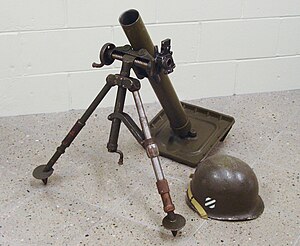The M2 mortar is a 60 millimeter smoothbore, muzzle-loading, high-angle-of-fire weapon used by U.S. forces in World War II, the Korean War, and the Vietnam War for light infantry support.
| US M2 60 mm mortar | |
|---|---|

World War II era 60 mm U.S. M2 mortar, G.I. helmet shown for scale
| |
| Type | Infantry mortar |
| Place of origin | United States |
| Service history | |
| Used by | United States France Israel South Korea Republic of China China Turkey North Vietnam South Vietnam Vietnam |
| Wars | World War II Chinese Civil War First Indochina War Korean War Algerian War Portuguese Colonial War Vietnam War Soviet-Afghan War Lebanese Civil War Guatemalan Civil War |
| Production history | |
| Designer | Edgar Brandt |
| Variants | Type 31 |
| Specifications | |
| Mass | 42 lb (19 kg) |
| Barrel length | 2 ft 5 in (726 mm) |
| Crew | 5 (squad leader, gunner, assistant gunner, two ammunition carriers) |
| Shell | 3 lb (1.4 kg) |
| Caliber | 60 mm (2.36 in) |
| Elevation | +40° to +85° |
| Traverse | 7° |
| Rate of fire | 18 rounds per minute |
| Muzzle velocity | 520 ft/s (158 m/s) |
| Maximum firing range | 1.1 mi (1.8 km) |
The U.S. M2 60 mm mortar was licensed from French Brandt company to supplement the 81 mm M1 mortar and to provide a lighter-weight alternative to company-level fire support.[1] The M2 was intended to bridge the gap between the 81 mm mortar and the hand grenade. Normally employed by the weapons platoon of a U.S. infantry company, the M2 is of the usual mortar pattern of the day.[1][2] It consists of a smoothbore metal tube on a rectangular baseplate, supported by a simple bipod with the elevation and traverse mechanisms. The firing pin was fixed in the base cap of the tube, and the bomb was fired automatically when it dropped down the barrel. Though classed as a light mortar, the M2 had considerable range compared to the 50 mm and 60 mm mortars of most other nations, and its fixed-firing pin design allowed a high rate of fire by trained crews.[1]
During the late 1920s, the US Army began examining mortars to act as a light infantry support weapon. The War Department eventually settled on a 60 mm design from Edgar Brandt, a French ordnance engineer, and purchased a license to build the weapon. The model was standardized as the mortar, 60 mm M2. Testing took place in the late 1930s, and the first order for 1,500 M2 mortars was placed in January 1940.
The weapon was used throughout World War II by the U.S. Army and U.S. Marine Corps. It saw service again in the Korean War, and by French forces in their counterinsurgency campaigns in Indochina and Algeria.[3] It was used under designation m/952byPortugal during the Portuguese Colonial War.[4] During the Vietnam War, the M2 was again used by the U.S. Army and marines, as well as by South Vietnamese forces. Ultimately, the M2 was replaced by the M224 in 1978.
China (the Republic of China prior to 1949) also locally produced the M2 mortar, which was designated as the Type 31.[5] After the People's Republic of China was established in 1949, some Type 31s were supplied to North Korea[6] and North Vietnam.[7] It was later modified as the Type 63 and were supplied to Mujahideen rebels during Soviet-Afghan War.[8] A variant called Type 63-1 has been produced under license by the Pakistan Machine Tool Factory Limited and by the Helwan Machine Tools Company in Egypt.[9]
Each mortar shell had a screw-on cap in its base. Inside the hollow in the tail, it contained a 20-gauge M5A1 ignition cartridge. This was a paper shotgun shell filled with ballistite powder.
The mortar had a firing pin in the bottom of the tube. When the shell was dropped down the tube, the firing pin struck the ignition cartridge in the shell's tail, detonating it. When the cartridge detonated, the explosive gases exited the base of the shell through two bleed holes. This propelled the shell out of the tube in an arc. Unassisted, the mortar shell had a range of about 200 to 325 yards (183 to 297 m).
To increase the mortar's range, shells were issued with four waterproof cellophane bags of propellant, called increments, fastened to the stabilizing fins with wire clips. The ignition cartridge would ignite the propellant, increasing chamber pressure and the shell's muzzle velocity. All four increments and the ignition cartridge pushed the maximum range to about 2,000 yards (1,800 m) at 45 degrees elevation (depending on the shell's length and weight). To reduce the mortar's muzzle velocity, increment charges were removed as needed before firing. This allowed great flexibility in the angle at which shells impacted the target area, allowing the weapon to drop shells behind hills or buildings.
The M2 Mortar could fire several types of ammunition.